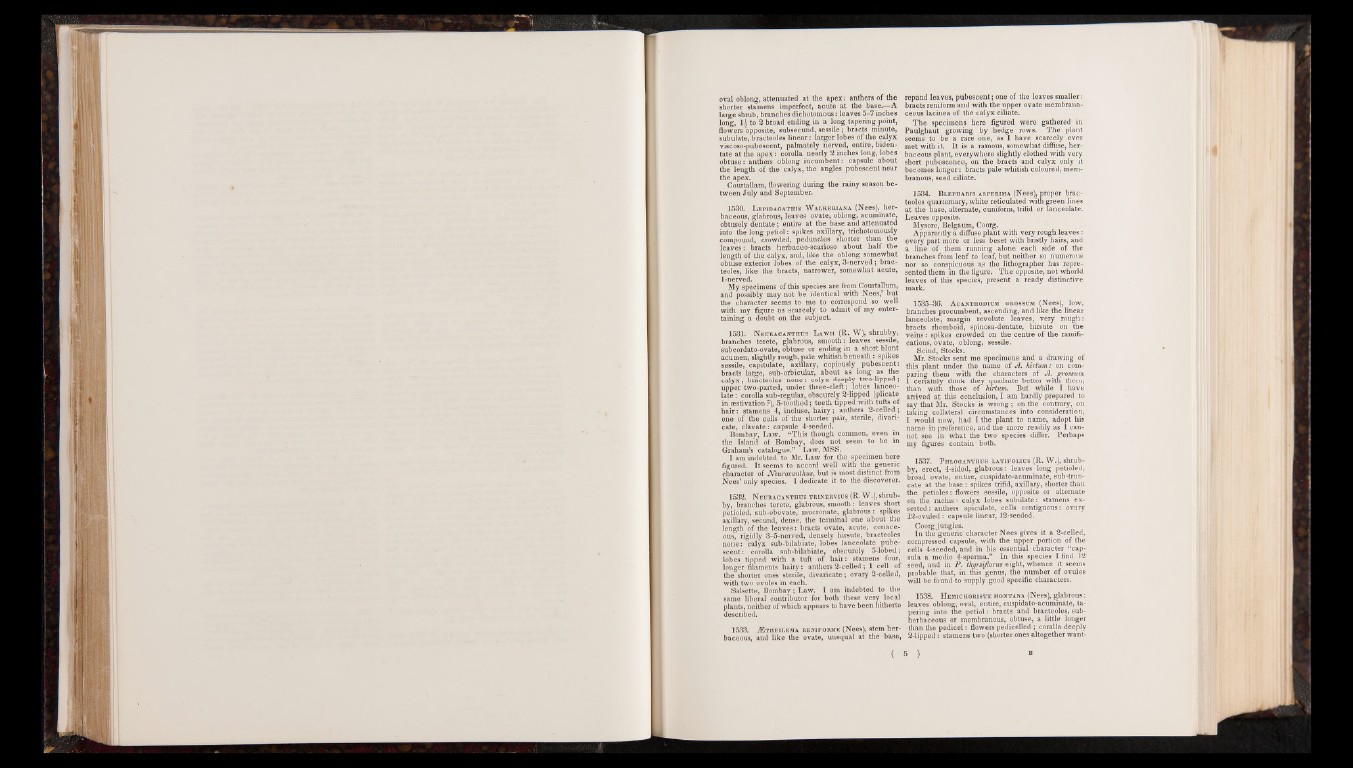
mr
oval oblong, attenuated at the apex: anthers of the
shorter stamens imperfect, acute at the base.—A
large shrub, branches dichotomous: leaves 5-7 inches
long, to 2 broad ending in a long tapering point,
flowers opposite, subsecund, sessile; bracts minute,
subulate, bracteoles linear: larger lobes of the calyx
viscoso-pubescent, palmately nerved, entire, biden-
tate at the apex: corolla nearly 2 inches long, lobes
obtuse: anthers oblong incumbent: capsule about
the length of the calyx, the angles pubescent near
the apex.
Courtallam, flowering during the rainy season between
July and September.
1530. Lepidagathis Waukeriana (Nees), herbaceous,
glabrous, leaves ovate, oblong, acuminate,
obtusely dentate; entire at the base and attenuated
into the long petiol: spikes axillary, trichotomously
compound, crowded, peduncles snorter than the
lea v e s: bracts herbaceo-scarioso about half the
length of the calyx, and, like the oblong somewhat
obtuse exterior lobes of the calyx, 3-nerved; bracteoles;
like the bracts, narrower, somewhat acute,
1-nerved.
My specimens of this species are from Courtallum,
and possibly may not be identical with Nees,’ but
the character seems to me to correspond so well
with my figure as scarcely to admit of my entertaining
a doubt on the subject.
1531. N euracanthus Lawii (R. W), shrubby,
branches terete, glabrous, smooth: leaves sessile,
subcordato-ovate, obtuse or ending in a short blunt
acumen, slightly rough, pale whitish beneath: spikes
sessile, capitulate, axillary, copiously pubescent:
bracts large, sub-orbicular, about as long as the
calyx; bracteoles none: calyx deeply two-lipped;
upper two-parted, under three-cleft; lobes lanceolate
: corolla sub-regular, obscurely 2-lipped (plicate
in aestivation ?), 5-toothed; teeth tipped with tufts of
hair: stamens 4, incluse, hairy; anthers 2-celled;
one of the cells of the shorter pair, sterile, divaricate,
clavate: capsule 4-seeded.
Bombay, Law. “This though common, even in
the Island of Bombay, does not seem to be in
Graham’s catalogue.” Law, MSS.
I am indebted to Mr. Law for the specimen here
figured. It seems to accord well with the generic
character of Neuracanthus, but is most distinct from
Nees’ only species. I dedicate it to the discoverer.
1532. N eoracanthus trinervxus (R. W.), shrubby,
branches terete, glabrous, smooth: leaves short
petioled, sub-obovate, mucronate, glabrous: spikes
axillary, secund, dense, the terminal one about the
length of the lea v e s: bracts ovate, acute, coriaceous,
rigidly 3-5-nerved, densely hirsute, bracteoles
none: calyx sub-bilabiate, lobes lanceolate pubescent
: corolla sub-bilabiate, obscurely 5-lobed;
lobes tipped with a tuft of hair: stamens four,
longer filaments hairy: anthers 2-celled; 1 cell of
the shorter ones sterile, divaricate; ovary 2-celled,
with two ovules in each.
Salsette, Bombay; Law. I am indebted to the
same liberal contributor for both these very local
plants, neither of which appears to have been hitherto
described.
1533. jEtheilema reniforme (Nees), stem herbaceous,
and like the ovate, unequal at the base,
repand leaves, pubescent; one of the leaves smaller:
bracts reniform and with the upper ovate membranaceous
lacinea of the calyx ciliate.
The specimens here figured were gathered in
Paulghaut growing by hedge rows. The plant
seems to be a rare one, as 1 have scarcely ever
met with it. It is a ramous, somewhat diffuse, herbaceous
plant, everywhere slightly clothed with very
short pubescence, on the bracts and calyx only it
becomes longer: bracts pale whitish coloured, membranous,
seed ciliate.
1534. Blepharis asperima (Nees), proper bracteoles
quarternary, white reticulated with green lines
at the base, alternate, cuniform, trifid or lanceolate.
Leaves opposite.
Mysore, Belgaum, Coorg.
Apparently a diffuse plant with very rough leaves :
every part more or less beset with bristly hairs, and
a line of them running alone each side of the
branches from leaf to leaf, but neither so numerous
nor so conspicuous as the lithographer has represented
them in the figure. The opposite, not whorld
leaves of this species, present a ready distinctive
mark.
1535-36. Acanthodium grossum (Nees), low,
branches procumbent, ascending, and like the linear
lanceolate, margin revolute leaves, very rough:
bracts rhomboid, spinosa-dentate, hirsute on the
v ein s: spikes crowded on the centre of the ramifications,
ovate, oblong, sessile.
Scind, Stocks.
Mr. Stocks sent me specimens and a drawing of
♦hi« plant under the name o f A. kirtum: on comparing
them with the characters of A. grossum
I certainly think they quadrate better with them,
than with those of hirtum. But while I have
arrived at this conclusion, I am hardly prepared to
say that Mr. Stocks is wrong; on the contrary, on
taking collateral circumstances into consideration,
I would now, had I the plant to name, adopt his
name in preference, and the more readily as I cannot
see in what the two species differ. Perhaps
my figures contain both.
1537. Phloganthus latifolius (R. W.), shrubby,
erect, 4-sided, glabrous: leaves long petioled,
broad ovate, entire, cuspidato-acuminate, sub-truncate
at the base: spikes trifid, axillary, shorter than
the petioles: flowers sessile, opposite or alternate
on the rachis: calyx lobes subulate: stamens ex-
serted: anthers apiculate, cells contiguous: ovary
12-ovuled: capsule linear, 12-seeded.
Coorg jungles.
In the generic character Nees gives it a 2-celled,
compressed capsule, with the upper portion of the
cells 4-seeded, and in his essential character “cap-
sula a medio 4-sperma.” In this species I find 12
seed, and in P . thyrsiflorus eight, whence it seems
probable that, in this genus, the number of ovules
will be found to supply good specific characters.
1538. Hemichoriste Montana (Nees), glabrous:
leaves oblong, oval, entire, cuspidato-acuminate, tapering
into the petiol: bracts and bracteoles, sub-
herbaceous or membranous, obtuse, a little longer
than the pedicel: flowers pedicelled; coralla deeply
2-lipped: stamens two (shorter ones altogether want